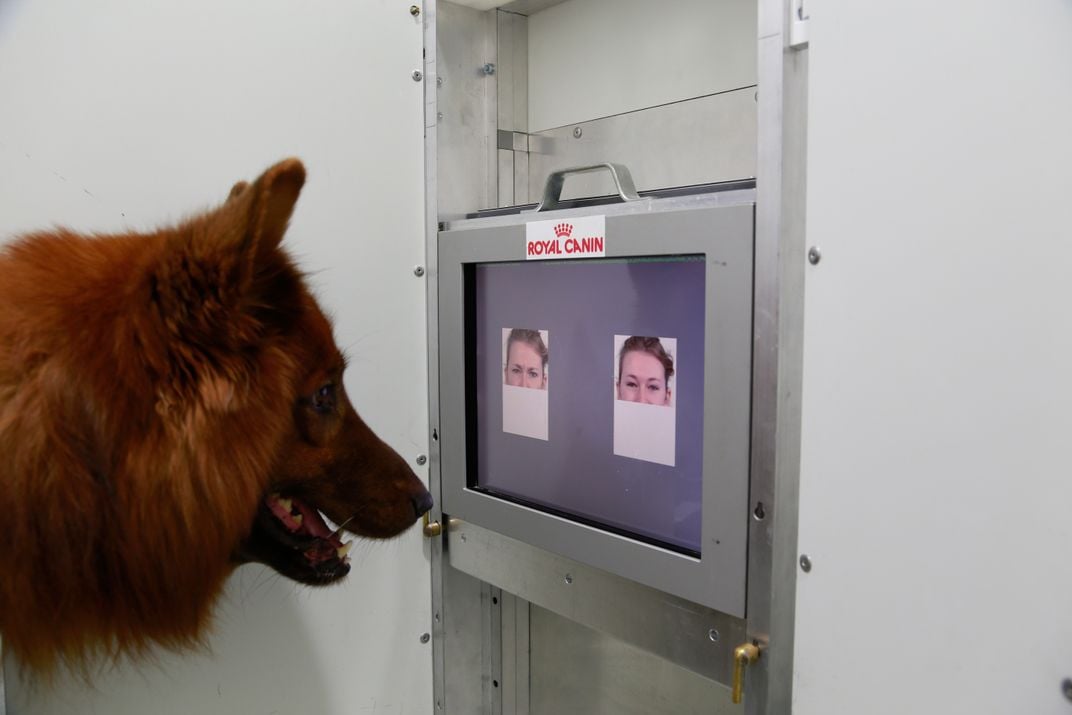Dogs Can Tell Whether You’re Making a Happy or Mad Face
For the first time, science shows that a non-human animal can recognize the emotional state of another species
/https://tf-cmsv2-smithsonianmag-media.s3.amazonaws.com/filer/03/d2/03d2785e-921f-4065-872b-66eec5ea6083/dog.jpg)
Facial expressions are a key asset in our arsenal of communication methods. Without saying a word, we can alert those around us to our emotional state—ranging from elation to sorrow—simply by flexing a few muscles. Such expressions have evolved to help us connect with one another, avoid danger and work together.
Fellow humans, however, are not the only ones potentially tuning in to the information our expressions convey. According to the results of a study published today in Current Biology, dogs have hacked this silent method of communication, at least enough to distinguish between angry and happy facial expressions.
Dogs and humans share a tight evolutionary bond, which is why veterinarian researchers from the University of Vienna decided to focus on these two species for their study. Dogs are already known to be whizzes at reading us. For instance, they can discriminate between familiar and unfamiliar faces even if just part of the face is shown in a photograph. Whether they actually recognize emotions, however, had not been conclusively investigated before.
The Vienna researchers needed to design an airtight experimental setup, free from potential emotional proxies that the canines could use to cheat the test. Dogs might learn, for example, that the presence of teeth corresponds with happy expressions but then wrongly interpret the flash of pearly whites in a snarl or shout.
To bypass any confounding variables, the researchers trained about a dozen pet dogs to distinguish between a neutral, forward-looking face and the back of the same person’s head, using a touch screen that the dogs operated with their nose. If they chose the forward-facing image correctly, they received a small reward.
The team then presented 11 of the trained dogs with images of either sad or happy faces. The team cropped the images into three types: just eyes, just a mouth and just the left side of the face. This way they could be sure the dogs were recognizing the signs of anger or happiness all over the face, not just by spotting a singular clue such as exposed teeth or furrowed eyebrows. Selecting the face with the correct expression earned the dog a treat.

After training the dogs with one familiar face, the researchers found that their subjects had little difficulty applying what they learned—the universal signs of human happiness or anger—to photos of faces they had never seen before. The team noted, however, that dogs were slower to correctly select the angry faces, perhaps a sign that the canines could already associate mad-looking expressions with bad outcomes and thus wanted to avoid those faces.
As far as the authors know, this is the first time researchers have shown that one animal species can recognize the emotional state of another (humans recognizing emotions in animals doesn’t count). The team points out, though, that it would come as no surprise if other animals have similar powers of interspecies communication, since the information offered by facial expressions could be handy for survival. A lioness recognizing whether a wildebeest is preparing to angrily charge or to flee just by regarding the squint of its eyes and flare of its nostrils could mean the difference between a mortal injury and dinner.
Before the authors delve into the greater animal kingdom, though, they plan to further explore their canine findings. Experiments with puppies could lend insight into whether facial expression recognition is something dogs learn over their lives or if it's something more innate. And trials with wolves could indicate whether human breeders bestowed emotion recognition in their canine companions via artificial selection, or whether that trait was something dogs’ ancient relatives developed on their own simply by living in the vicinity of humans.
While the initial controlled laboratory findings don’t prove that your dog is watching your every facial move for clues about how you are feeling, they do open up the possibility that dogs are even more empathetic best friends than we thought.
/https://tf-cmsv2-smithsonianmag-media.s3.amazonaws.com/accounts/headshot/Rachel-Nuwer-240.jpg)
/https://tf-cmsv2-smithsonianmag-media.s3.amazonaws.com/accounts/headshot/Rachel-Nuwer-240.jpg)